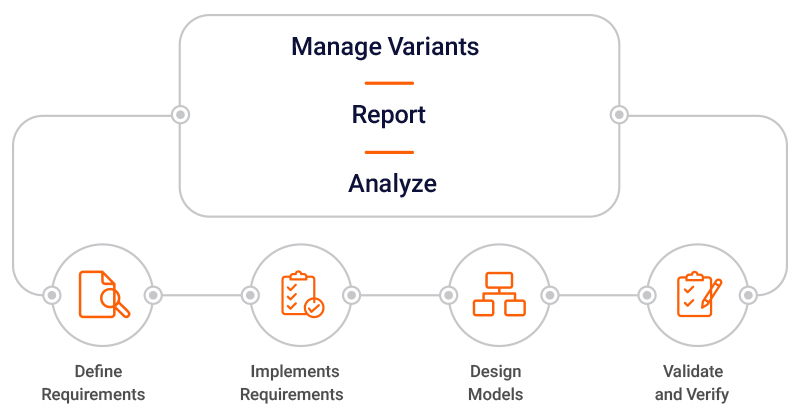The release of version 7.0 of IBM’s Enterprise Lifecycle Management (ELM) toolset has left many industrial organizations to wonder which version offers the best solution to their needs — the new version 7.0, or an earlier version 6.x, previously known as IBM Continuous Engineering (CE)?
Persistent Systems is IBM’s ELM software development partner.
We are trusted by IBM with the continued support and development of the ELM toolset, and we use it every day to manage ELM’s development across our global teams.
Persistent Systems is making this deep, practical experience available to industrial organizations through our Persistent ELM 7.0 Readiness Service.
What is Persistent ELM 7.0 Readiness Service?
Developers of complex software-driven and connected products are looking for an end-to-end, integrated system and software development solution for complex product management and engineering. Many who recognize the value of IBM ELM and are looking to harness the power of ELM 6.x and 7.x want to understand
- Which version of ELM is right for my organization?
- What changes to my IT infrastructure are needed to ensure ELM runs in its optimal state?
- What other preparations are needed to maximize the success of my ELM integration?
Persistent ELM 7.0 Readiness Service deploys Persistent ELM integration experienced engineers to answer these questions by fully understanding
- What types of products you are developing.
- What tools you use currently to manage your product development and engineering.
- Where your current challenges and opportunities lie with your current software.
- How your IT environment supports your product development and/or system engineering efforts.
Once that information has been gathered and analyzed, Persistent will provide
- Recommendations as to which version of ELM is right for your specific business needs, now and in the near future.
- A journey map to ensure your organization can leverage the benefits of the optimal ELM toolset with little to no disruption of your ongoing operations.
- A migration plan to ensure every one of your potentially millions of requirements and artifacts are retained and accurately converted into modern ELM versions require, with a line of sight back to the original requirement.
What factors determine my organization’s ELM readiness?
Every business situation is different, of course, but there are several criteria we consider for every client exploring the adoption of ELM version 6.x or 7.x.
These criteria include
- Your urgency: How quickly do you need to migrate from your current solution? Are you looking at weeks, months or years?
If you’re not on version 6.x currently and you ultimately need to get to 7.x for the scalability improvement it delivers, we often suggest clients migrate to 6.x first, then move to 7.x once your
6.x instance is stable. For many organizations, the benefits of 6.x may be all they need. - The age of your current ELM toolset: It’s not uncommon for Persistent to engage with industrial organizations still running much older versions such as IBM CE 4.0, which can be well beyond their end-of-life and end-of-support dates.
The only support option for these aging products is through expensive extended service contracts that rely on patches to keep the applications running. This can be a serviceable short-term solution but not advisable in the long run. Here again, a two-step migration to 6.x and then 7.x may be the best path to success. - Your audit and compliance needs: What industries do you support? How many different products do you manufacture? How many variants of each product do you need? With what industry, government, or other standards body regulations must you demonstrate compliance?
If you manufacture products for the aerospace, automotive, medical device, or electronics industries, compliance needs are likely a growing concern. You may have several variants for each product that must meet the regulatory needs
of your various standards bodies and regulatory organizations. That means rapidly increasing complexity to manage the growing number of products and variants you produce.
ELM 7.0 was developed to deliver “insightful engineering at enterprise scale” by increasing the capacity of the repository for product requirements from 2 million to 20 million, and the number of contributions in a global configuration from 25 contributions to 2,500 contributions – enough for 99% of the world’s automobile manufacturers. - The number of tools within ELM currently in use: The ELM toolset consists of five primary tools that can be acquired in any combination, depending on your needs. Simply updating the current tools might be a relatively simple exercise.
Expanding the number of tools — particularly the adoption of DOORS NG requirements management tool — often requires additional physical and virtual infrastructure to provide the optimal platform for the needs of your applications. - Your appetite for change: Given how quickly complex product management and systems engineering has evolved in the Fourth Industrial Revolution, your team’s capacity for change may be a significant factor in your overall readiness.
While a two-stage migration may be favorable from a technical perspective, it may have a negative impact on your employee engagement, depending on how much “change fatigue” they have from previous initiatives.
Your team’s training needs and your leadership group’s capacity to drive successful change are critically important factors we consider as part of our Persistent ELM 7.0 Readiness Service.
Assessing a complex industrial organization’s readiness to adopt ELM 6.x or 7.0 is much more involved than these five simple variables above, but organizations can conduct their own preliminary readiness assessments using the criteria above.
How can I learn more about the benefits of ELM 6.x or 7.x for my business?
To help industrial organizations get a deeper understanding of ELM and which version is the right toolset for them, Persistent is conducting a multi-part series of webinars titled “Supercharging ELM” related to specific aspects of ELM, integration with other modern manufacturing platforms and open standards, and industry and OEM compliance.
Click here to register for the upcoming webinar from the Supercharging ELM webinar series.
About the Author
Geoffrey Clemm
Distinguished Engineer at Persistent Systems
To fulfill his role as a distinguished engineer for Persistent Systems, Geoffrey Clemm relies on more than 30 years of industrial experience designing, implementing, and deploying software development tools. His primary responsibilities include IBM’s Engineering Lifecycle Management (ELM) offerings and Software Configuration Management technologies.
Geoff is the primary author of RFC-3253, the standard versioning protocol of the Internet Engineering Task Force (IETF), and he is the specification lead for JSR-147, the Java Community Process (JCP) standard versioning API.
In addition to his development responsibilities, Geoff is the technical advocate for a set of large enterprise early adopter customers, where he guides their deployment and usage of the ELM solution.
Geoff holds a bachelor’s degree in Applied Mathematics from Harvard College, as well as a Ph.D. in Computer Science from the University of Colorado at Boulder.
Bertrand Raillard
Offering Manager,
Persistent Integration Platform
Bertrand Raillard is responsible for leading the integration products and services offerings at Persistent Systems, enabling customers to create truly end-to-end digital solutions using their preferred engineering platform.
To accomplish this, Bertrand relies on 25 years of experience in the software industry, with the last two decades focused on supporting a variety of industries and manufacturers of everything from blast furnaces and grain silos to jet fighters and chewing gum.
Bertrand holds a bachelor’s degree from ISTEC, the Institute of Higher Education in Marketing and Commerce in Paris, France.







